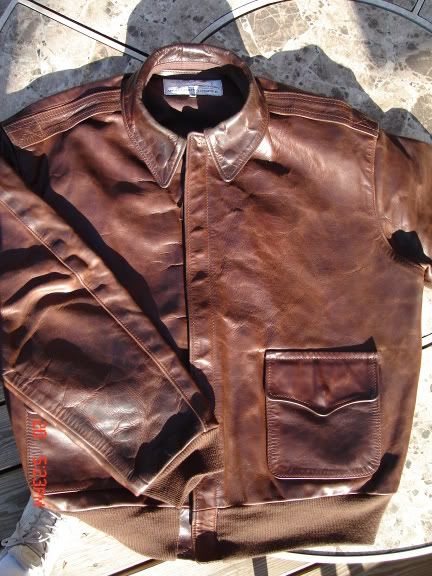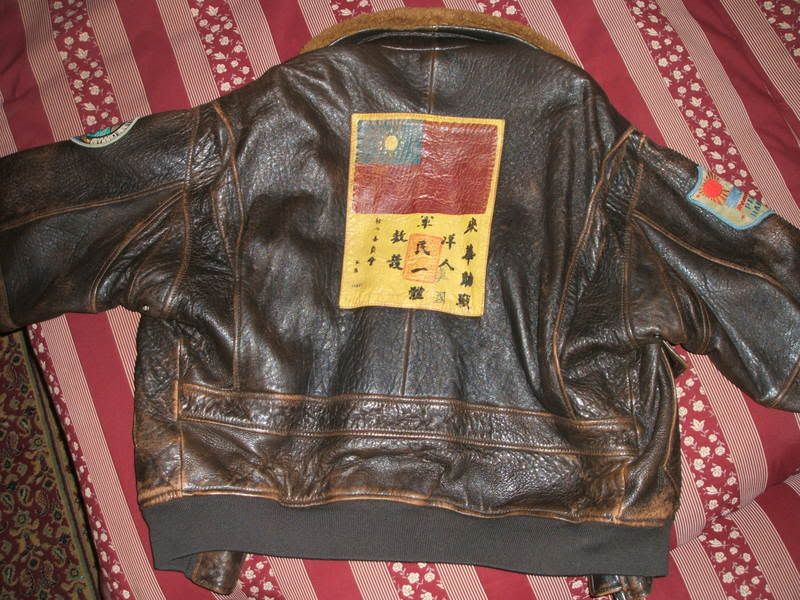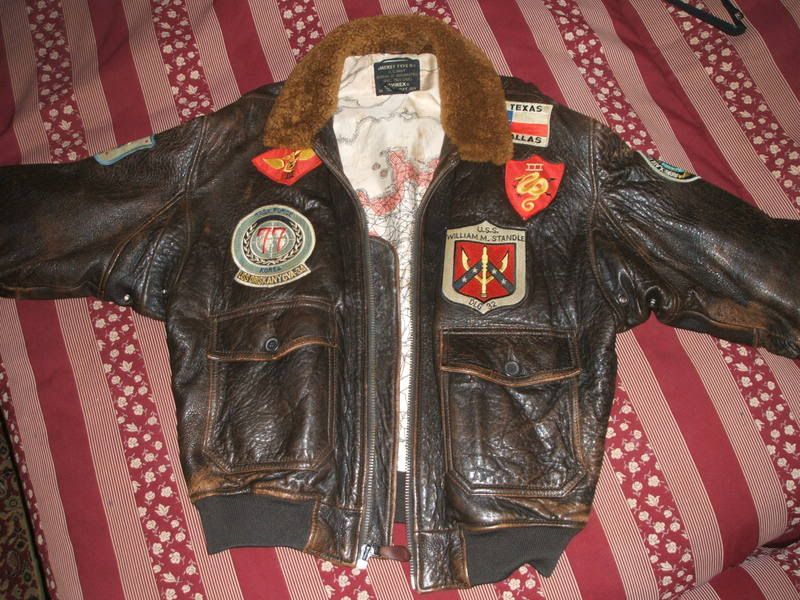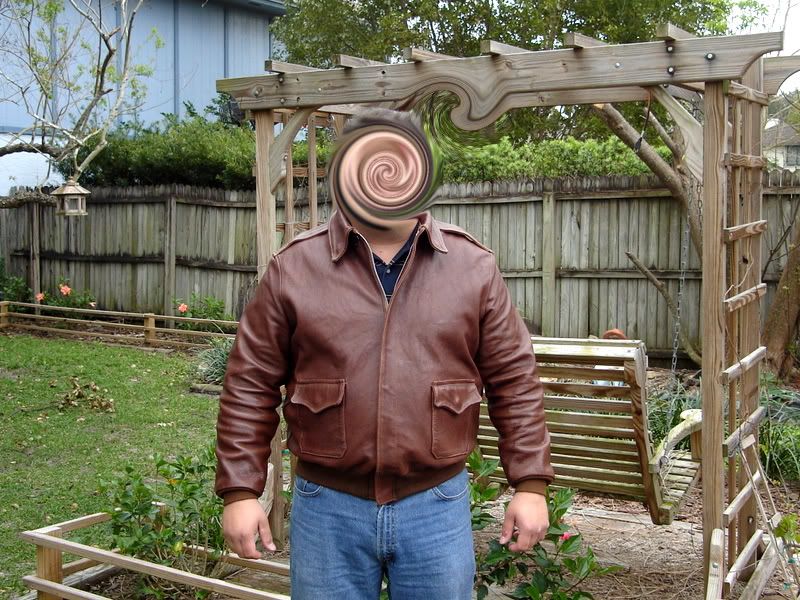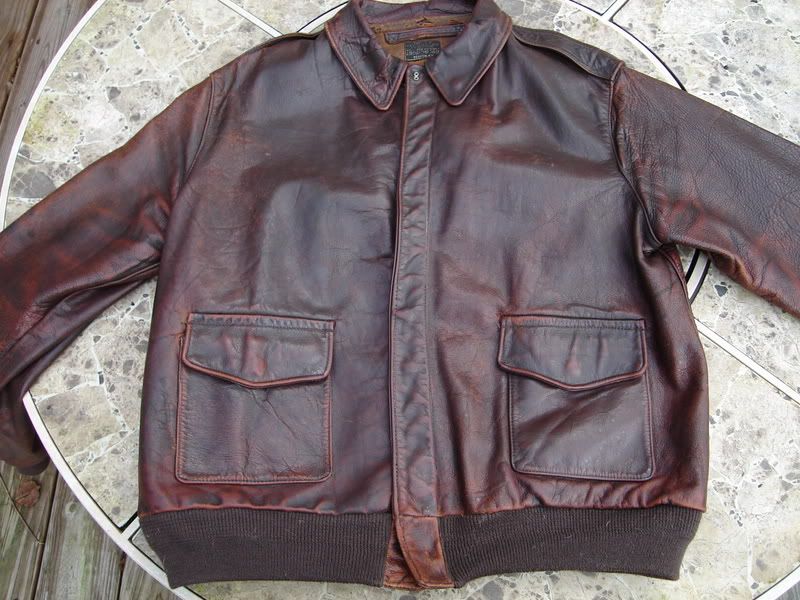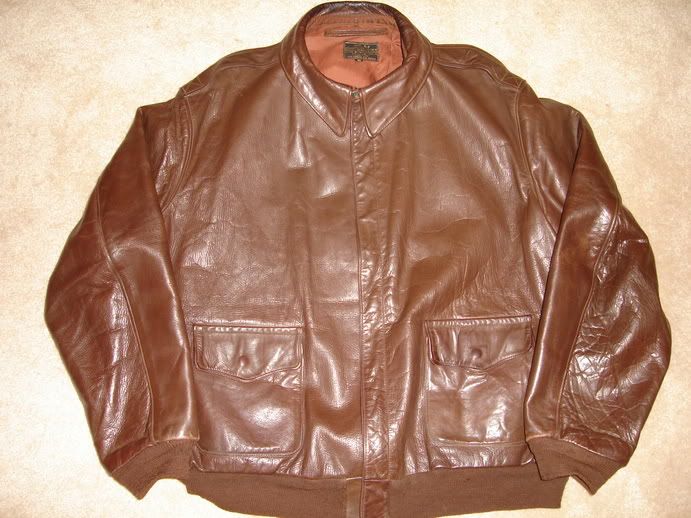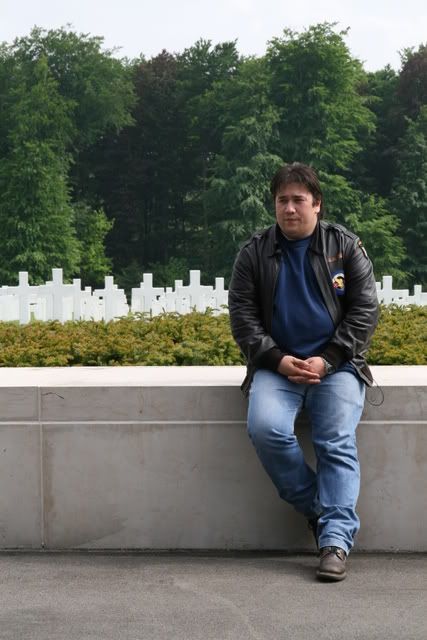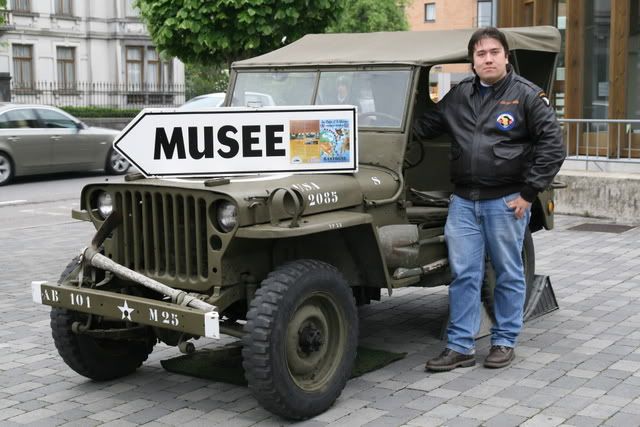Post your A-2's here....
Posted: Sun Aug 24, 2008 12:11 am
Any WWII era A-2's? Also, if there is any particular history about the jacket, please disclose. Thanks!
The Type A-2 leather flight jacket is one of the most classic and immediately recognizable articles of military clothing ever designed. It is most closely associated with World War II U.S. Army pilots, who often decorated their jackets with squadron patches and elaborate artwork painted on the back. Sometimes casually referred to as a "bomber" jacket, its original designation was "Jacket, Pilot's (summer)," and its wartime usage was limited neither to pilots nor to bomber crews.
The Type A-2 flying jacket was standardized by the U.S. Army Air Corps as the successor to the Type A-1 flying jacket adopted in 1927. The Type Designation Sheet lists the dates for Service Test as September 20, 1930, and Standardized (adopted as standard issue) on May 9, 1931. The military specification number for Type A-2 is 94-3040. The Drawing Number was given as 31-1415, but the spec. labels found in the jackets themselves show this to be 30-1415.
On April 27, 1943, Type A-2 was declared Limited Standard, meaning that only replacements for in-service units could be ordered. New units would now be supplied with cloth-shelled jackets such as Types B-10 and B-15.
The U.S. Army Air Forces Class 13 Catalog listed the garment as "Jacket, Flying, Type A-2," with Spec. No. 94-3040. It describes the jacket's construction as "seal brown horsehide leather, knitted wristlets and waistband (skirt)." Broadly similar in construction to the A-1, it replaced the A-1's buttoned front and pocket flaps with a zipper and hidden snap fasteners (although some very early A-2's retained the pocket buttons). The A-1's stand-up knitted collar, which buttoned closed, was supplanted in the A-2 by a shirt-style leather collar, with hidden snaps at the points and a hook-and-eye latch at the throat. Stitched-down shoulder epaulets were also added to the design. Sizes were listed as ranging in even numbers from 32 through 54.
Although the actual design would vary slightly depending on the manufacturer, and even among contracts within a single manufacturer, all A-2 jackets had several distinguishing characteristics: a snap-flap patch pocket on either side that does not have hand warmer compartments (hands in pockets were considered unfit for a military bearing), a shirt-style snap-down collar, epaulets, knit cuffs and waistband, a back constructed from a single piece of leather to limit stress on the garment, and a lightweight silk or cotton inner lining with a military spec tag attached just below the back collar. Prior to WW2 the collar was sewn to a neckband or "stand" like those found in dress shirts, a time-intensive operation. Wartime contracts generally had "simple attached" collars sewn directly to the back panel and rolled over although Roughwear and Perry continued using the collar stand throughout.
Most pre-war and wartime A-2's were constructed of horsehide, which was either vegetable- or chrome-tanned. Some original A-2's were made from goatskin (as was the Navy G-1 jacket), and others possibly from cowhide (which can be very difficult to tell from horse if tanned identically). All Spiewak and Doniger jackets are of goat, as are many Cable, Dubow, Bronco, Perry, and Rough Wear examples.
Wartime-issued A-2 jackets appear in a wide range of color tones and hues, although all are based on two distinct colors: Seal (dark brown to almost black) and Russet (pale red-brown to medium brown). Most seal jackets were russets re-dyed during the war to cover scuffing and discoloration, although some contracts, like the Aero Leather AC-21996, were dyed seal right from the start. Original knit cuffing typically matched the leather or came close, but exceptions exist, such as Aero Leather's eye-catching rust-red cuffing on seal brown hide.
Early A-2's had linings made from silk, per the original specification. This was likely spun silk, a thin, breathable shirt-like fabric. The lining changed to cotton later on. A letter from the Materiel Division of Wright Field, dated 7 January 1939, states that the use of silk in flying jackets had been discontinued "as its procurement was found not to be feasible." The letter does not say when this happened, but it makes clear that the vast majority of original A-2 jackets have cotton linings. (Reference?)
Zippers were made of steel or brass, and some were nickel plated. Known zipper suppliers were Talon, Crown, Conmar, and Kwik, with Talon providing the majority of zippers used in wartime A-2 construction.
Unlike modern, loose-fitting jackets, the original A-2 looks to us today a rather trim-fitting jacket. Period photos and films reveal a jacket which could be worn fitted and sharp looking or a bit baggy and loose in the body. It was designed to fit the thinner male of the time- original A-2 jackets worn by modern men may seem a bit snug in the shoulders. This is particularly true of pre-war contract garments such as the 1933 Werber and the 1938 and 1940 Aero Leathers. Period photos and films show that the A-2 was typically worn over a shirt or a shirt and flight suit; airmen were more likely to switch to a sheep-lined jacket or electrified flight suit for wintertime or high-altitude operations.
Manufacturers
There were many manufacturers of A-2 jackets during the 1930s and 1940s, whose product showed a wide range of quality, workmanship, and fit characteristics. These included civilian clothing producers such as David D. Doniger & Co., makers of the popular MacGregor brand outerwear, as well as leather-goods companies like J.A. Dubow Mfg., whose chief peacetime product was baseball mitts.
Aero Leather Clothing Co., Inc., Beacon, NY*
Air Associates, Inc., Garden City, NY**
Bronco Mfg. Corp., New York, NY
Cable Raincoat Co., Boston, MA
Cooper Sportswear Mfg. Co., Newark, NJ
David D. Doniger & Co., New York, NY
H.L.B. Corp. (possibly H.&L. Block Corp. or a spinoff firm), New York, NY**
J.A. Dubow Mfg. Co., Chicago, IL
Monarch Mfg. Co., Milwaukee, WI
Perry Sportswear, Inc., Newburgh, NY
Poughkeepsie Leather Coat Co., Inc., Poughkeepsie, NY
Rough Wear Clothing Co., Middletown, PA
Security Sportswear Co., Chicago, IL**
I. Spiewak & Sons, North Bergen, NJ
Star Sportswear Mfg. Co., Lynn, MA
United Sheeplined Clothing Co., Long Branch, NJ
Werber Leather Coat Co., Beacon, NY** (reorganized in the mid-1930s as Werber Sportswear Co., Newburgh, NY*)
* Pre-war and wartime contractor.
** Pre-war contractor only.
Security Sportswear's Order No. 32-485, placed in 1932, is the earliest A-2 jacket order of which records remain.
At least three A-2 contracts, Nos. 1756, 42-18246-P, and W535-AC-23383, bear no maker name on the label.
The Type A-2 leather flight jacket is one of the most classic and immediately recognizable articles of military clothing ever designed. It is most closely associated with World War II U.S. Army pilots, who often decorated their jackets with squadron patches and elaborate artwork painted on the back. Sometimes casually referred to as a "bomber" jacket, its original designation was "Jacket, Pilot's (summer)," and its wartime usage was limited neither to pilots nor to bomber crews.
The Type A-2 flying jacket was standardized by the U.S. Army Air Corps as the successor to the Type A-1 flying jacket adopted in 1927. The Type Designation Sheet lists the dates for Service Test as September 20, 1930, and Standardized (adopted as standard issue) on May 9, 1931. The military specification number for Type A-2 is 94-3040. The Drawing Number was given as 31-1415, but the spec. labels found in the jackets themselves show this to be 30-1415.
On April 27, 1943, Type A-2 was declared Limited Standard, meaning that only replacements for in-service units could be ordered. New units would now be supplied with cloth-shelled jackets such as Types B-10 and B-15.
The U.S. Army Air Forces Class 13 Catalog listed the garment as "Jacket, Flying, Type A-2," with Spec. No. 94-3040. It describes the jacket's construction as "seal brown horsehide leather, knitted wristlets and waistband (skirt)." Broadly similar in construction to the A-1, it replaced the A-1's buttoned front and pocket flaps with a zipper and hidden snap fasteners (although some very early A-2's retained the pocket buttons). The A-1's stand-up knitted collar, which buttoned closed, was supplanted in the A-2 by a shirt-style leather collar, with hidden snaps at the points and a hook-and-eye latch at the throat. Stitched-down shoulder epaulets were also added to the design. Sizes were listed as ranging in even numbers from 32 through 54.
Although the actual design would vary slightly depending on the manufacturer, and even among contracts within a single manufacturer, all A-2 jackets had several distinguishing characteristics: a snap-flap patch pocket on either side that does not have hand warmer compartments (hands in pockets were considered unfit for a military bearing), a shirt-style snap-down collar, epaulets, knit cuffs and waistband, a back constructed from a single piece of leather to limit stress on the garment, and a lightweight silk or cotton inner lining with a military spec tag attached just below the back collar. Prior to WW2 the collar was sewn to a neckband or "stand" like those found in dress shirts, a time-intensive operation. Wartime contracts generally had "simple attached" collars sewn directly to the back panel and rolled over although Roughwear and Perry continued using the collar stand throughout.
Most pre-war and wartime A-2's were constructed of horsehide, which was either vegetable- or chrome-tanned. Some original A-2's were made from goatskin (as was the Navy G-1 jacket), and others possibly from cowhide (which can be very difficult to tell from horse if tanned identically). All Spiewak and Doniger jackets are of goat, as are many Cable, Dubow, Bronco, Perry, and Rough Wear examples.
Wartime-issued A-2 jackets appear in a wide range of color tones and hues, although all are based on two distinct colors: Seal (dark brown to almost black) and Russet (pale red-brown to medium brown). Most seal jackets were russets re-dyed during the war to cover scuffing and discoloration, although some contracts, like the Aero Leather AC-21996, were dyed seal right from the start. Original knit cuffing typically matched the leather or came close, but exceptions exist, such as Aero Leather's eye-catching rust-red cuffing on seal brown hide.
Early A-2's had linings made from silk, per the original specification. This was likely spun silk, a thin, breathable shirt-like fabric. The lining changed to cotton later on. A letter from the Materiel Division of Wright Field, dated 7 January 1939, states that the use of silk in flying jackets had been discontinued "as its procurement was found not to be feasible." The letter does not say when this happened, but it makes clear that the vast majority of original A-2 jackets have cotton linings. (Reference?)
Zippers were made of steel or brass, and some were nickel plated. Known zipper suppliers were Talon, Crown, Conmar, and Kwik, with Talon providing the majority of zippers used in wartime A-2 construction.
Unlike modern, loose-fitting jackets, the original A-2 looks to us today a rather trim-fitting jacket. Period photos and films reveal a jacket which could be worn fitted and sharp looking or a bit baggy and loose in the body. It was designed to fit the thinner male of the time- original A-2 jackets worn by modern men may seem a bit snug in the shoulders. This is particularly true of pre-war contract garments such as the 1933 Werber and the 1938 and 1940 Aero Leathers. Period photos and films show that the A-2 was typically worn over a shirt or a shirt and flight suit; airmen were more likely to switch to a sheep-lined jacket or electrified flight suit for wintertime or high-altitude operations.
Manufacturers
There were many manufacturers of A-2 jackets during the 1930s and 1940s, whose product showed a wide range of quality, workmanship, and fit characteristics. These included civilian clothing producers such as David D. Doniger & Co., makers of the popular MacGregor brand outerwear, as well as leather-goods companies like J.A. Dubow Mfg., whose chief peacetime product was baseball mitts.
Aero Leather Clothing Co., Inc., Beacon, NY*
Air Associates, Inc., Garden City, NY**
Bronco Mfg. Corp., New York, NY
Cable Raincoat Co., Boston, MA
Cooper Sportswear Mfg. Co., Newark, NJ
David D. Doniger & Co., New York, NY
H.L.B. Corp. (possibly H.&L. Block Corp. or a spinoff firm), New York, NY**
J.A. Dubow Mfg. Co., Chicago, IL
Monarch Mfg. Co., Milwaukee, WI
Perry Sportswear, Inc., Newburgh, NY
Poughkeepsie Leather Coat Co., Inc., Poughkeepsie, NY
Rough Wear Clothing Co., Middletown, PA
Security Sportswear Co., Chicago, IL**
I. Spiewak & Sons, North Bergen, NJ
Star Sportswear Mfg. Co., Lynn, MA
United Sheeplined Clothing Co., Long Branch, NJ
Werber Leather Coat Co., Beacon, NY** (reorganized in the mid-1930s as Werber Sportswear Co., Newburgh, NY*)
* Pre-war and wartime contractor.
** Pre-war contractor only.
Security Sportswear's Order No. 32-485, placed in 1932, is the earliest A-2 jacket order of which records remain.
At least three A-2 contracts, Nos. 1756, 42-18246-P, and W535-AC-23383, bear no maker name on the label.
